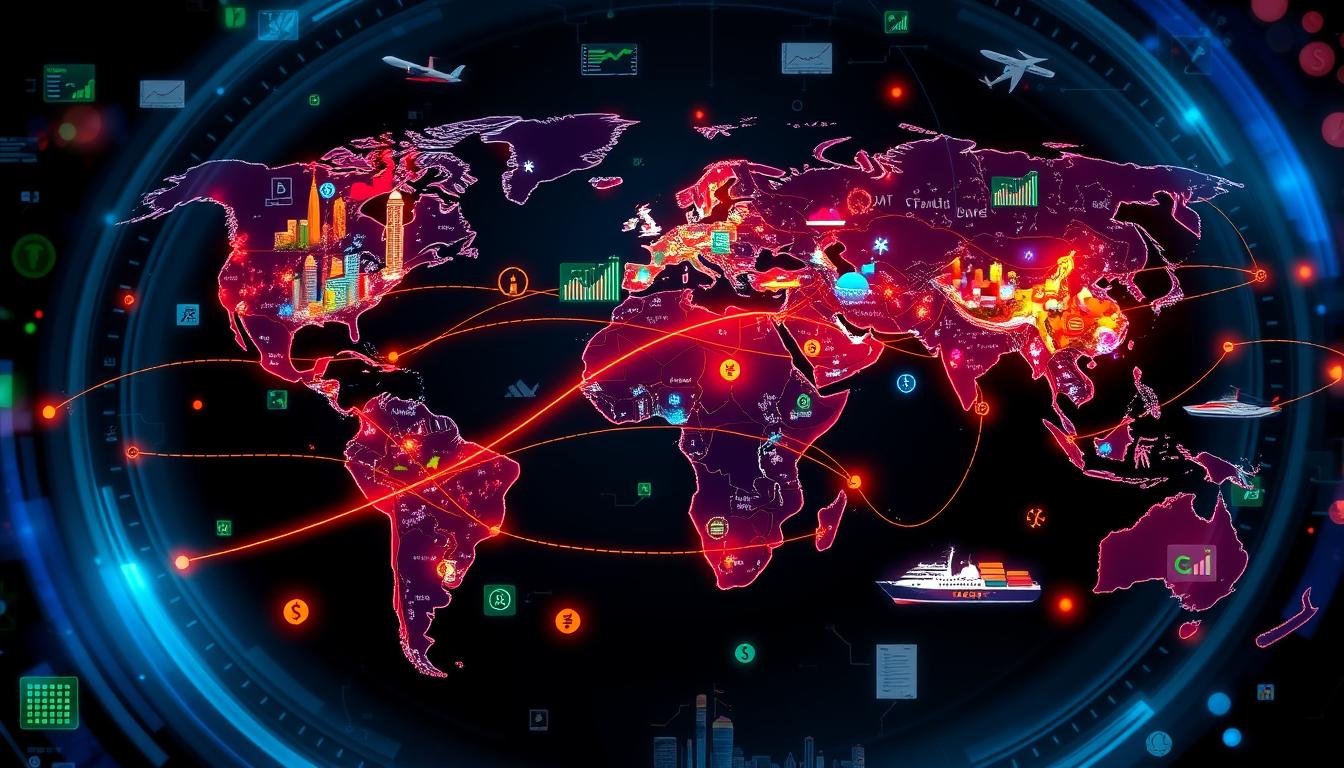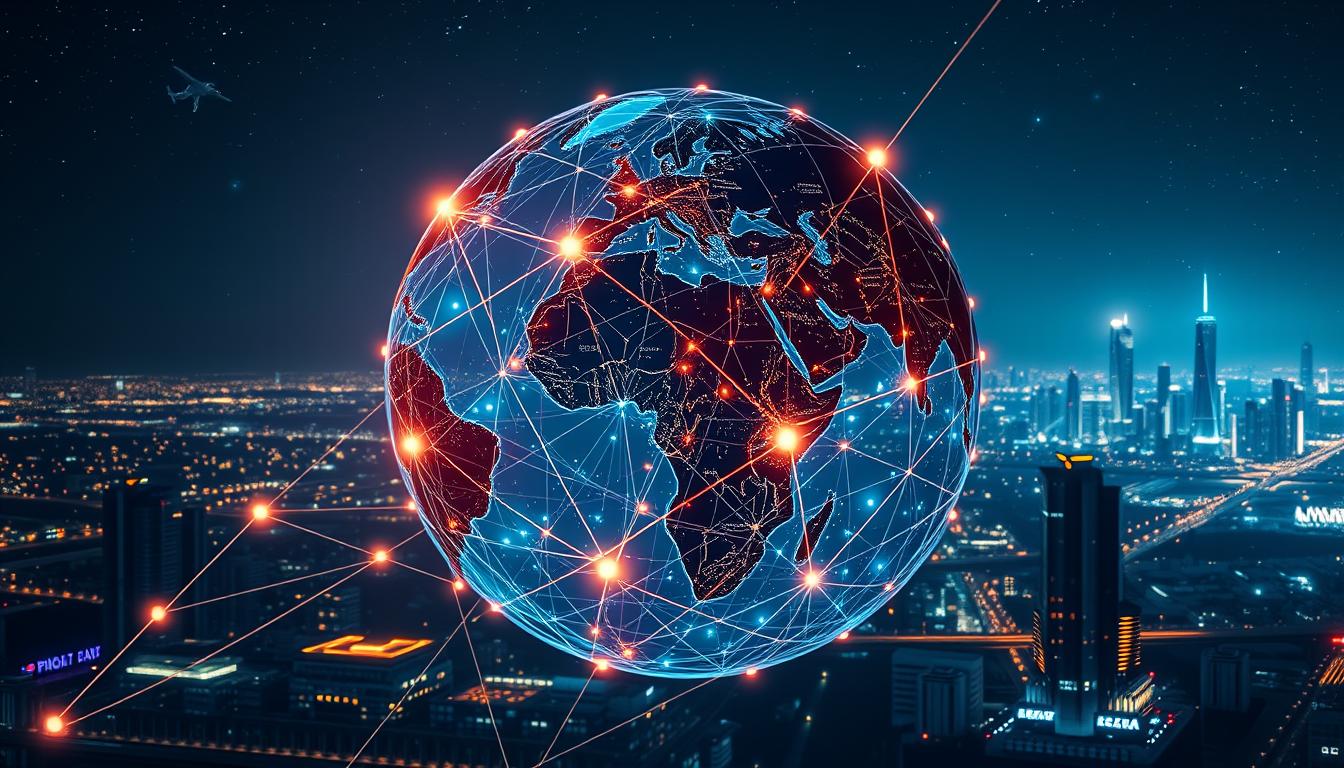In today’s fast-paced world, the influence of globalization on business trends is undeniable. The landscape of international markets is undergoing monumental changes, driven by interconnected economies and cultural exchanges. As global corporations expand their reach, they’re not just changing their operations; they are reshaping market dynamics across the globe. The economic globalization impact is fascinating, as companies leverage unique resources and efficiencies worldwide to stay competitive.
Advancements in technology, communication, and transportation have enabled global enterprises to engage in diverse countries. This has opened new pathways to customer bases that were previously inaccessible. However, this newfound interdependence also brings business globalization challenges, such as political unrest and regulatory differences that can affect operations. In this section, we’ll explore how these shifting dynamics are molding the future of business on a global scale.
Key Takeaways
- Globalization promotes cost-effective manufacturing, benefiting developed nations.
- Developing countries gain job opportunities due to their attractiveness for foreign investment.
- Economic downturns in one region can affect global trade partners significantly.
- Globalization has led to industry disruptions, particularly in traditional sectors.
- Wealth concentration is a notable consequence of globalization, impacting economic equity.
- Trade agreements like NAFTA and USMCA shape operational frameworks for businesses.
- Consumer preferences are evolving amidst the homogenization of products worldwide.
Understanding Globalization
Grasping the concept of globalization is crucial in today’s interconnected world. It’s about the increased linkages among nations, promoting the exchange of goods, services, ideas, and cultures. This process has deeply impacted economic integration, pushing many firms to adopt global strategies for better efficiency.
It’s fascinating to see that global trade, capital, and people flows stayed strong during the Covid-19 pandemic. This shows globalization’s enduring strength. Despite the decoupling between the U.S. and China, a full split into rival blocs hasn’t happened globally. Geopolitical tensions haven’t stopped globalization; they’ve made it clear that adaptable strategies are key.
The World Bank highlights that globalization has cut extreme poverty by 35% since 1990, lifting 1.1 billion people out of severe poverty. This success story fuels hope for the benefits of working together across borders.
Companies looking to expand into new markets often face hurdles like finding the right talent and meeting compliance standards. It’s crucial to adapt operations to local culture, valuing diversity while tackling challenges like language differences.
Companies like Nestlé and PepsiCo show the perks of having a global footprint. They use local insights while keeping a unified strategy across the globe. Understanding and valuing cultural differences is key to success in global markets. For more insights into handling international challenges, check out this resource on cloud computing trends.
The Historical Context of Globalization
The history of globalization reveals a complex tapestry of connections across centuries. Ancient trade routes laid the groundwork, with contributions from diverse civilizations. The industrial revolution brought a transformative shift, reshaping trade and commerce fundamentally. Innovations like steam engines and shipping advancements facilitated the global movement of goods.
The term globalization gained prominence in the late 20th century, but global interaction predates this era. By 1960, Anne O. Krueger noted a decline in globalization and economic integration compared to earlier decades. This highlights the fluctuating nature of global trade.
Globalization offers numerous benefits, including access to a global labor pool and resources at competitive prices. This benefits consumers by providing a wide variety of products. However, it also raises concerns about cultural homogeneity and environmental impacts from mass production.
Globalization’s roots are centuries old, but the term became prominent post-World War II. New policies promoting free trade and open borders emerged during this period. The G20’s formation in 1999 underscored the growing need for international cooperation, with countries like the European Union, China, and India gaining prominence.
Technology has been a driving force behind globalization. Innovations in communication and transportation have fostered a more interconnected world. The internet, artificial intelligence, and blockchain have accelerated this trend, facilitating information flow and efficient market transitions.
Since the post-World War II era, global economic systems have continued to evolve. From the Roman Empire to the Silk Road and modern practices, globalization remains crucial. This ongoing wave of interaction and integration marks a significant chapter in economic cooperation, competition, and exchange.
Globalization Business Trends
Recent trends in globalization show how businesses are adapting to a fast-evolving economic scene. Economic interdependence is on the rise, with countries and companies navigating complex supply chains, consumer trends, and political shifts. These developments highlight the dynamic nature of today’s business environment.
The Rise of Worldwide Economic Interdependence
Global market shifts have forced businesses to reevaluate their strategies. Post-COVID-19, companies have expanded their supply chains and refined their inventory management. They’ve also restructured their global footprint, deciding on optimal production locations. This is crucial, given forecasts that protectionist policies could increase in 2024, affecting global trade.
Key Players in Global Markets
Leading corporations from developed countries still hold significant economic power. Yet, emerging markets are making strides, capitalizing on new opportunities. In the U.S., public opinion on international trade is mixed, influenced by worries over job losses and supply chain issues. Meanwhile, Europe’s concerns about Chinese electric vehicle subsidies show the intricate nature of global trade.
Trends in Consumer Preferences Across Borders
Consumer behavior is leaning towards global brands, leading to more uniform global markets. While regional tastes still exist, there’s a growing preference for products that appeal worldwide. The shift to remote work, spurred by the pandemic, has altered commuting habits and consumer spending patterns. This has, in turn, affected housing prices and environmental concerns. As housing affordability becomes a bigger issue, calls for innovative housing policies are gaining traction.

The Role of Technology in Globalization
Technology has profoundly altered globalization, making international business operations more streamlined and collaborative. Advances in communication technology have significantly boosted connectivity, enabling instant messaging and video conferencing worldwide. This has empowered businesses to swiftly adapt to market changes and consumer demands.
Advancements in Communication Technology
Modern communication technologies have transformed how companies engage with customers and partners. Tools like social media, video conferencing, and instant messaging apps facilitate real-time interaction and collaboration. These advancements foster transparency and trust, significantly enhancing relationships. By adopting these technologies, companies can better navigate diverse markets, responding more adeptly to local needs.
The Impact of E-Commerce on Global Markets
E-commerce has fundamentally changed the retail landscape, allowing companies to reach customers globally. Platforms such as Amazon and Alibaba enable small businesses to compete globally. Technology ensures a seamless online shopping experience, giving businesses access to millions of potential customers worldwide. This shift has accelerated the growth of global supply chains, with companies sourcing components from various locations to fulfill consumer demands efficiently.
To stay competitive, organizations are leveraging data analytics to refine their strategies. This technology not only helps businesses understand consumer behavior but also enables them to tailor products effectively. Automation has increased efficiency, leading to significant cost reductions. The integration of technology offers vast opportunities for growth in the interconnected global economy.
Political Changes Driving Globalization
Political shifts have a profound effect on globalization, reshaping the international trade scene. Governments often engage in trade agreements to reduce tariffs and remove trade obstacles. These agreements foster foreign investment by establishing a stable environment for businesses aiming to enter new markets.
In recent decades, the trend of migration has surged significantly. Currently, three times more people live in countries not their birthplace than in 1970. With urbanization on the rise, with 66 percent of the globe’s population expected to live in cities by 2050, political structures must evolve to accommodate this shift and its economic implications.
The push for trade liberalization has spurred privatization across various areas, intensifying global competition. Countries now see foreign investment as crucial for economic expansion, leading to the creation of trade deals that draw in capital and resources. Geopolitical tensions and emerging super election cycles in 2024 could challenge current political stability, complicating discussions on globalization.
Technological advancements, especially in AI, are transforming traditional business models, sparking worries about job losses and social disparities. These developments force governments to reform policies in line with changing market conditions and citizen demands.
Emerging Market Opportunities
Emerging markets are a treasure trove of high-growth opportunities for businesses. As globalization advances, pinpointing regions ready for expansion is crucial. These markets, marked by developing economies and swelling consumer bases, are reshaping the business landscape. Grasping how to capitalize on these chances can distinguish your business from rivals.
Identifying High-Growth Regions
Recently, some regions have surged as prime growth areas. Southeast Asia and parts of Africa stand out as magnets for expansion. The composite purchasing managers’ index in these emerging markets signals sustained growth, unlike the stagnation in developed regions. The drivers of these growth opportunities include:
- A robust increase in foreign direct investment.
- Young, dynamic populations with rising disposable incomes.
- A trend of diversification in global supply chains away from established centers like China.
Strategies for Entering New Markets
Adapting your market entry strategies is vital when venturing into emerging markets. Companies can choose from several approaches, such as:
- Partnerships and Joint Ventures: Teaming up with local firms aids in navigating cultural and operational hurdles.
- Direct Investment: Setting up a local presence ensures better control and alignment with market needs.
- Localized Marketing: Customizing your marketing to suit local tastes boosts success chances.
- Leveraging Digital Platforms: The digital economy’s growth makes e-commerce a potent tool for reaching consumers.
In conclusion, effective strategies and a deep understanding of the market will empower your business to seize the potential of emerging markets.

Global Trade Patterns
For businesses venturing into the global market, grasping global trade patterns is crucial. Trade agreements significantly influence market dynamics and boost efficiency across borders. They streamline commerce, aiding companies in refining their supply chain logistics and responding to global market shifts.
How Trade Agreements Shape Markets
Trade agreements profoundly affect global trade. They slash tariffs, abolish trade hurdles, and establish a stable trading framework. This leads to heightened sales and market entry for enterprises. The African Continental Free Trade Area’s adoption exemplifies a pledge to broaden trade among member states, thus fostering economic expansion.
Cross-Border Supply Chains and Logistics
In today’s interconnected economy, the efficacy of supply chain logistics is paramount. Companies are broadening their supply chains to include nations like Mexico, Bangladesh, and Vietnam. This shift towards near-shoring cuts down on shipping durations and expenses. Yet, businesses must navigate through regulatory evolutions, such as the Corporate Sustainability Due Diligence Directive. This directive underscores the importance of ethical sourcing and responsible practices within supply chains.

Challenges of Business Globalization
Expanding your business across borders brings numerous challenges. You’ll face regulatory hurdles unique to each international market. It’s crucial to grasp these regulatory frameworks to reduce risks in international business.
Understanding Regulatory Environments
Regulatory frameworks differ widely across countries. These differences lead to challenges for businesses. Key areas to consider include:
- Tariffs: Tariffs can significantly impact the cost of goods traded internationally.
- Import/Export Restrictions: These restrictions can limit market entry.
- Bureaucratic Hurdles: Navigating administrative complexities can slow operations and increase costs.
Understanding regulatory challenges is key to entering foreign markets successfully. Without this knowledge, you may face operational setbacks and increased risks. Prioritizing compliance is vital for long-term success in global markets.

Digital Transformation in Global Business
Digital transformation is transforming global business operations. Companies are adopting advanced technology to refine their strategies, making them agile and efficient. This shift enables firms to innovate, connect better with customers, and streamline operations. It helps them adapt swiftly to the fast-paced changes in global business strategies.
How Technology is Reshaping Business Strategies
Integrating digital technologies into business models is causing profound changes in operations. Multinational firms can now bypass traditional processes, speeding them up while cutting costs and improving their response to market changes. This flexibility is essential, particularly when government policies and consumer trends shift, as seen during the COVID-19 pandemic.
- Operational Agility and Efficiency: Digital transformation leads to better productivity and cost savings through automation.
- Global Connectivity and Market Expansion: Businesses can now reach a wider audience through e-commerce, bypassing the need for physical market presence.
- Data-Driven Decision Making: Access to valuable data insights helps companies reduce risks and make informed decisions across diverse cultural and economic landscapes.
- Enhanced Customer Experience: CRM systems and personalized marketing strategies improve customer engagement and satisfaction worldwide.
- Innovation and Competitive Edge: Embracing digital transformation fosters an innovative environment through technologies like blockchain and artificial intelligence.
- Flexibility in Supply Chain Management: IoT and blockchain technologies enhance transparency and real-time tracking, making supply chains more adaptable to disruptions.

Conclusion
The future of globalization is marked by a significant shift in international trade, reshaping business landscapes. Since 1913, exports have skyrocketed over 40 times, highlighting the pivotal role of globalization theories in shaping current business trends. Today, companies face a complex global market that demands continuous adaptation and innovation.
Trade has grown significantly, now accounting for about 25% of global GDP, up from less than 10% before 1870. This surge underscores trade’s critical role in economic growth. Technological advancements have redefined supply chains and market strategies, offering new opportunities. It’s vital to embrace these changes to remain competitive in a dynamic market.
The shift from labor-cost arbitrage to high-value services demands a nuanced understanding of market dynamics. Digital transformation in global business introduces new challenges and opportunities. Staying informed and agile is crucial. For deeper insights, explore this resource on future industrial shifts. Your ability to adapt will define your success in the complex global economy.
FAQ
What is globalization in the context of business?
How does technology influence globalization?
What are the main challenges of business globalization?
Which regions are considered emerging markets?
What impact do trade agreements have on globalization?
How can companies adapt to changing consumer preferences in a global market?
What role does digital transformation play in global business strategies?
Source Links
- Globalization in Business With History and Pros and Cons – https://www.investopedia.com/terms/g/globalization.asp
- Current Trends in Global Business – https://courses.lumenlearning.com/wm-principlesofmanagement/chapter/current-trends-in-global-business/
- The State of Globalization in 2023 – https://hbr.org/2023/07/the-state-of-globalization-in-2023
- Globalization Benefits and Challenges – https://velocityglobal.com/resources/blog/globalization-benefits-and-challenges/
- What Is Globalization in Business? | HBS Online – https://online.hbs.edu/blog/post/what-is-globalization-in-business
- When Did Globalization Start? – https://www.investopedia.com/ask/answers/020915/when-did-globalization-start.asp
- What is Globalization: Pros, Cons, and History | Definition from TechTarget – https://www.techtarget.com/searchcio/definition/globalization
- The Trends That Will Define the Global Economy in 2024 – ProMarket – https://www.promarket.org/2024/01/26/the-trends-that-will-define-the-global-economy-in-2024/
- Globalization in 2024: the clouds are clearing – I by IMD – https://www.imd.org/ibyimd/2024-trends/globalization-in-2024-the-clouds-are-clearing/
- Influence of Technology on Globalization: History, Trends, and Future for Emerging Market Economies (EMEs) – https://www.linkedin.com/pulse/influence-technology-globalization-history-trends-future-adediji
- Role of technology in globalization – FasterCapital – https://fastercapital.com/startup-topic/role-of-technology-in-globalization.html
- Navigating The Future: 10 Global Trends That Will Define 2024 – https://www.forbes.com/sites/bernardmarr/2023/10/31/navigating-the-future-10-global-trends-that-will-define-2024/
- The impact of economic, political and social globalization on overweight and obesity in the 56 low and middle income countries – https://www.ncbi.nlm.nih.gov/pmc/articles/PMC4416723/
- The Top Global Business Trends for 2024 – https://www.uschamber.com/international/top-global-business-trends-for-2024
- Strategies That Fit Emerging Markets – https://hbr.org/2005/06/strategies-that-fit-emerging-markets
- Emerging markets outlook, October 2023 – https://www2.deloitte.com/us/en/insights/economy/emerging-markets-outlook.html
- The top ten trends shaping the future of international trade – https://www.gbm.hsbc.com/en-gb/insights/international/the-top-ten-trends-shaping-the-future-of-international-trade
- Global trade and the new geoeconomic reality – https://www2.deloitte.com/us/en/insights/topics/strategy/global-trade-trends-and-geopolitical-issues.html
- Global trade has nearly flatlined. Populism is taking a toll on growth – https://blogs.worldbank.org/en/voices/global-trade-has-nearly-flatlined-populism-taking-toll-growth
- 5 Common Challenges of International Business | HBS Online – https://online.hbs.edu/blog/post/challenges-of-international-business
- 00-55248-pre-pr – https://www.unido.org/sites/default/files/2006-10/mrak_0.pdf
- International business in the digital age: Global strategies in a world of national institutions – https://www.ncbi.nlm.nih.gov/pmc/articles/PMC10072045/
- The Impact of Digital Transformation on International Business Growth – https://www.linkedin.com/pulse/impact-digital-transformation-international-business-growth-singh-nuxqc
- Trade and Globalization – https://ourworldindata.org/trade-and-globalization
- Globalization in transition: The future of trade and value chains – https://www.mckinsey.com/featured-insights/innovation-and-growth/globalization-in-transition-the-future-of-trade-and-value-chains


